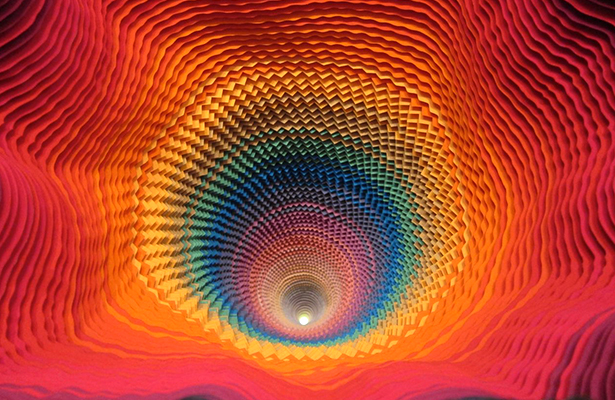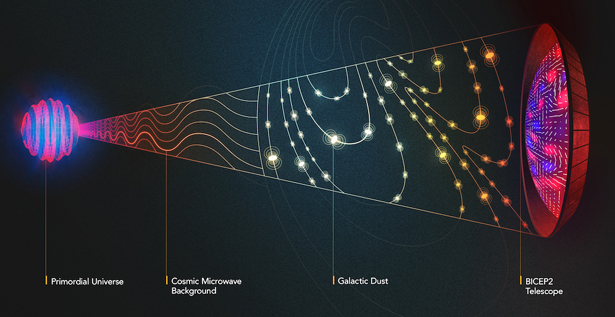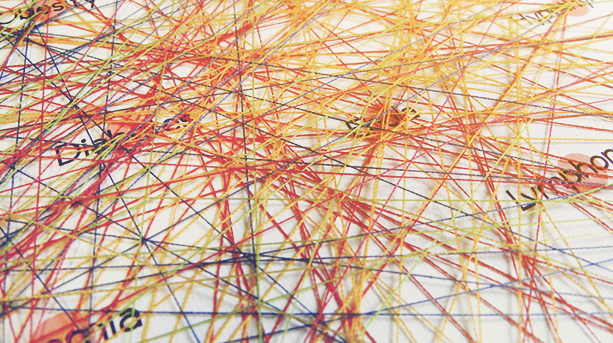Joint Dust Analysis Deflates Big Bang Signal

Last March, when a group of astronomers announced that they had detected faint swirls in the sky that almost certainly reflected undulations in the shape of the early universe, experts agreed it could be one of the greatest cosmological discoveries of all time. If confirmed, the undulating “gravitational waves” would amount to near-proof of the Big Bang theory known as inflation, and their magnitude would reveal exactly how energetically the universe inflated 13.8 billion years ago, when, according to the theory, it grew from a speck in a fraction of a second.
But soon, many had doubts. The rising skepticism was validated this week, with a definitive analysis showing that the swirl pattern detected by the astronomers fits the profile of radiating space dust rather than gravitational waves.
Scientists cross-checked the data, which were gathered by the BICEP2 telescope, pixel-for-pixel against observations by the Planck telescope, which was better attuned to differences between dust and gravitational waves. The analysis confirmed what a previous Planck study suggested: Dust obscuring the patch of the sky probed by BICEP2 generated most if not all of the observed swirl pattern.
The results appeared in a leaked press release Thursday evening intended to accompany a paper that has been submitted for publication in Physical Review Letters.
So where, one might ask, does the new analysis leave the theory of cosmic inflation?
That no definitive gravitational wave signal could be seen through the dusty haze does not imply that the waves don’t exist, but rather translates into a new upper bound on how strong they could be, given that they have managed to stay under the telescopes’ radar. The finding confirms that a few models of inflation are eliminated, but does not disprove the 35-year-old theory itself, which in most models would have generated gravitational waves too gentle for the telescopes to detect.

“I have always tried to emphasize that inflation was not the thing at stake here, actually,” said Eva Silverstein, a theoretical physicist at Stanford University, referring to the debate over the BICEP2 claim.
The majority of cosmologists maintain that the case for inflation is substantial. It has successfully predicted a number of detailed features of the cosmos. And so far, the only alternative explanation for those features — a cyclic, breathing-lung model of the universe — strikes many as overly complicated and theoretically dicey.
“It’s as if you had five witnesses who fingered the same suspect, and a sixth one whose eyesight wasn’t that good who couldn’t really tell,” said Marc Kamionkowski, an astrophysicist at Johns Hopkins University. Ten years from now, if telescopes 100 times more sensitive than BICEP2 still see no gravitational waves, he said, “that might make us wonder.”
The reversal has nonetheless reinvigorated critics of inflation, who are seizing the opportunity to highlight its weaknesses. Their chief objections lie in the conceptual puzzles that arise from trying to understand what could have triggered such an event — issues they claim are exacerbated in the class of inflationary models that remain viable.
Even supporters of inflation, still the leading Big Bang theory, acknowledge its incompleteness as a story of how and why the universe began.
“It’s a theory that explains observations,” said David Spergel, a theoretical cosmologist at Princeton University. “But it’s also a theory that raises a lot of questions.”
Game of Chances
In the beginning, according to the inflation hypothesis, there existed not an infinitely hot and dense point (as in the original Big Bang theory) but a field of energy permeating space, known as the “inflaton field.” Somehow, an enormous upsurge of energy beset a patch of the field. (In a popular version of the story, known as “chaotic inflation,” the amount of energy varied randomly throughout the field, like crests and troughs in a choppy sea.) Unlike matter, which gravitationally attracts, the energy stored in the inflaton field exerted a repulsive force. It caused the patch to expand like the surface of an inflating balloon. The exponential growth spurt lasted only about 0.00000000000000000000000000000000001 second before the energy diluted, but this was long enough to produce the huge, smooth bubble of space and time that we see today.
Meanwhile, some cosmologists reason, other universes might have bubbled up elsewhere in the inflaton field, enacting alternate realities beyond our reach.
“You just play the game of chances,” said Andrei Linde, a professor of physics at Stanford who, along with Alexei Starobinsky and Alan Guth, won the 2014 Kavli Prize in astrophysics for pioneering the theory of inflation. “Parts where you have wrong initial conditions remain small and irrelevant. Parts where the inflaton potential energy is large will inflate, and produce huge universes like ours.”
Inflation explains many characteristics of the universe. It would have functioned as a great equalizer, stretching out irregularities that existed in our pre-inflationary speck like wrinkles on a balloon’s surface, and rendering the cosmos remarkably smooth and flat. Indeed, the density of the universe when it was 380,000 years old varied by just one part in 100,000 according to observations of the oldest light in the sky. (The slightly over-dense spots grew into galaxies.) And a constant called omega that measures the universe’s curvature is pegged at 1.000, signifying perfect flatness.
But amid the uniformity, there are subtle deviations that serve as the true hallmarks of inflation.
The inflaton field would have roiled with quantum ripples of energy — spontaneously created pairs of particles and antiparticles. Under normal circumstances, these opposites instantly annihilate, like two waves canceling each other out. But as the universe expanded exponentially, the twin ripples were yanked apart, and forced to survive. They formed the tiny density variations observed in the early universe. (Ripples must also have arisen and stretched in the fabric of space-time itself; these are the yet-undetected gravitational waves.)
The observed density fluctuations even carry a subtle signature of inflation’s slowdown. Ripples that arose early in the course of inflation were stretched the most and are responsible for variations on large scales, such as the measured differences in density between one half of the cosmos and the other. Ripples that arose at later times correspond to density variations on smaller scales. But as inflation wound down and the energy of the inflaton field diluted at a slowing rate, fewer quantum ripples would have arisen. Indeed, observations by the Planck telescope have confirmed what earlier experiments suggested: The density of the early universe varied a few percent less on small scales than on large scales.
“The fact that the fluctuations do vary a bit with scale, but deviate by just the amount predicted by inflationary models, I think is a triumph,” Spergel said.
Unlikeliness Problem
No one has devised an alternative to inflation that explains so many observations with so much economy. For a decade, Paul Steinhardt of Princeton University, an early pioneer of inflation who has since become one of its most vocal critics, has championed the “ekpyrotic model,” a cyclical picture in which the universe executes an eternal series of expansions and contractions. In this scenario, any unevenness that develops in the cosmos as it expands gets compressed as it contracts. The slate is wiped clean for each cosmic rebirth, accounting in this way for the exceptional uniformity observed early on in this latest iteration.
But the ekpyrotic model has few subscribers. It hinges on the idea that the universe will bounce, rather than bang, each time it shrinks to a point. The theoretical arguments for why it should bounce strike most experts as highly speculative. And the non-bounciness of black holes suggests it would not do so.
At present, inflation has cornered the market on Big Bang theories, and yet there is still room for doubt. “The fact that we don’t have an alternative doesn’t mean we know the truth,” said Avi Loeb, a theoretical astrophysicist at Harvard University.
The theory’s triumphs are undercut by a strange detail: If inflation works the way it’s supposed to, it seems that it should never have happened at all.
The “unlikeliness problem,” revived by Anna Ijjas, a postdoctoral researcher at Princeton, along with Steinhardt and Loeb, in a much-discussed 2013 paper, holds that the gravitationally repulsive energy stored in the inflaton field would pale in comparison to other, gravitationally attractive forms of energy. This means that patches of the field where the repulsive energy dominates and drives inflation would be exceedingly rare.
The showstopping attractive energy derives from the inflaton field’s fluctuations across time and space. These fluctuations must be small for the repulsive energy to dominate and trigger inflation. But what suppresses them? “The field is going to be flying all over the place,” Steinhardt said. “The probability that it starts off at rest is infinitesimally tiny.”
Inflation now seems less likely than ever, the critics say. The fact that the BICEP2 and Planck telescopes didn’t see gravitational waves (and that the waves therefore must be weaker than a certain level) lowers the range for the amount of repulsive energy that could have driven inflation. This means an even smoother pre-inflationary patch would have been required than in the eliminated models.
And the more uniform the patch had to be, Ijjas said, the less inflation explains about the smoothness and flatness observed later on. “You really need to ask, ‘What do I get from inflation?’” she said. “Inflation was introduced to solve the problem of these special conditions [after] the Big Bang, but it requires these special initial conditions itself. That’s very unsatisfactory for me.”
Before the Bang
Early-universe experts concede that the paper by Ijjas and her colleagues raises some interesting questions. But they say it’s speculative to try and gauge the odds that conditions would have been ripe for inflation. “I don’t think we understand the inflaton field well enough to say it’s exponentially unlikely,” Spergel said.
The requisite conditions — namely, a flat patch of the inflaton field in which repulsive energy beats out attractive energy — might follow naturally from an underlying “theory of everything” that includes the inflaton field as a component. Silverstein, who specializes in string theory, a candidate for such an underlying framework, deemed the issue of initial conditions “an interesting question, but a separate question.”
Cosmologists are answering one question at a time. Half a century ago, the original Big Bang model applied the laws of gravity to account for the expansion of the universe, “but it said nothing about what set that expansion in motion in the first place,” Kamionkowski said. “Inflation in some sense is an idea for explaining what set the expansion in motion in the first place. I say ‘in some sense,’ because we still have to explain how inflation got started.”
Inflation has deferred the question of why the universe began to an earlier beginning. But the question remains.



